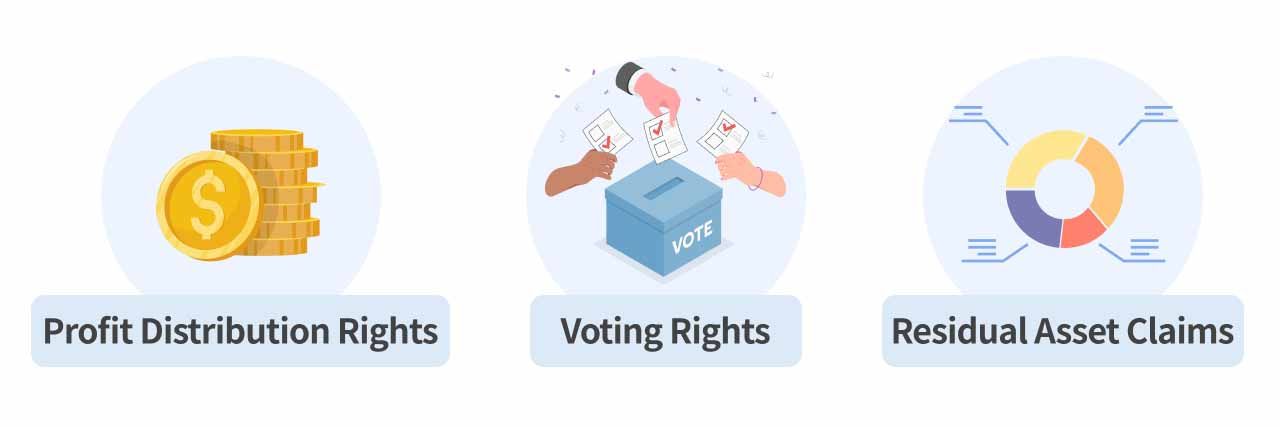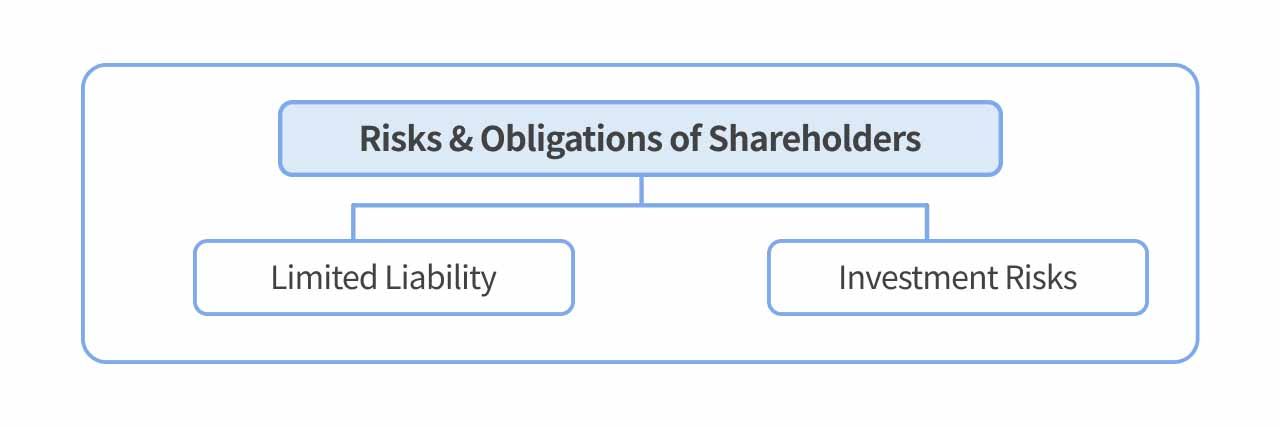Basic Concept of Equity
Simply put, equity represents ownership in a company. In everyday terms, when you, as an investor, buy shares of a company’s publicly traded stock, you essentially become a part-owner of that company.
The core concept of equity revolves around ownership shares—a company can divide its ownership into multiple equal parts, called shares, which investors can purchase. The more equity an investor holds, the greater their control over the company.
What is Stock? How is it Different from Equity? Many people use the terms "stock" and "equity" interchangeably, but they are slightly different. Equity represents ownership, while stock is the proof of that ownership. Buying and selling stock is essentially the transfer of equity (ownership and related rights).
For a more detailed introduction to stocks, check out this article: A must-read for stock market beginners! What are stocks? What are the benefits of investing in stocks?
| Investor | Initial Capital Contribution | Original Equity Structure | New Equity Structure After Equity Swap |
|---|---|---|---|
| You | $400,000 | 40% | 36% |
| Friend A | $300,000 | 30% | 27% |
| Friend B | $200,000 | 20% | 18% |
| Friend C | $100,000 | 10% | 9% |
| Beverage R&D Expert | — | — | 10% |
Imagine you and your friends decide to open a bubble tea shop together. Initially, you need substantial capital for rent, equipment, and ingredients, so you agree to divide ownership based on investment amounts. If the total capital needed is $1 million, and you invest $400,000, you own 40% of the company. Your three friends invest the remaining capital and hold 30%, 20%, and 10% of the shares, respectively.
Now, suppose your team lacks expertise in beverage development and wants to bring in an industry expert. Instead of paying in cash, you offer them 10% ownership in exchange for their expertise (equity swap). At this point, ownership is no longer solely based on capital contributions but also factors in strategic value and technical skills.
Rights of Shareholders

Holding equity in a company grants shareholders certain rights, but also comes with risks and obligations.

Illustrator of rights of profit distribution, voting, and claims for residual assets.
Profit Distribution Rights
Since most companies operate for profit, shareholders are entitled to a share of the company’s profits. When a company earns a profit in a given financial year, investors are generally entitled to dividends based on their ownership percentage, unless otherwise specified.
Dividend Policy Process: After investing in a publicly listed company and becoming a shareholder, dividend distribution generally follows this process: The board of directors drafts a dividend distribution plan—either cash dividends or stock dividends—based on the company’s profit performance from the previous year, current financial status, and future development plans.
In Taiwan, according to a directive from the Ministry of Economic Affairs, cash dividends fall under the authority of the board of directors. Therefore, if the company only distributes cash dividends, it only needs to report the decision to the shareholders’ meeting without requiring a vote. However, if the company plans to issue stock dividends, the proposal must be submitted to and approved by the shareholders’ meeting before implementation. It’s worth noting that a company’s dividend policy is not solely determined by its profits—it also requires a comprehensive evaluation of its financial health and future growth plans. As such, even if a company was profitable in the previous year, it does not guarantee a dividend payout. The final decision depends on the company’s overall business strategy.
Voting Rights
Under normal circumstances, shareholders have the opportunity to vote on major corporate decisions, such as significant investments, the election of directors and supervisors, major mergers and acquisitions, or amendments to the company’s Articles of Incorporation. In the absence of a special shareholding structure, each unit of shareholding typically corresponds to an equivalent voting right.
Dual-Class Stock Structure Some companies use dual-class stock structures to provide founders and executives with greater control by issuing different classes of shares with unequal voting power.
Example: Alphabet (Google’s Parent Company)
Class A shares (GOOGL): Publicly traded, 1 vote per share
Class C shares (GOOG): No voting rights, but similar stock price to Class A
Class B shares: Held by founders & executives, 10 votes per share, not publicly traded
This structure allows founders to maintain control while enabling public investment.
Residual Asset Claims
In addition, when a company enters liquidation, shareholders are entitled to claim a share of the remaining assets. After the company has settled all debts owed to creditors, any remaining undistributed assets will be allocated to shareholders, who, as the owners of the company, have the right to receive these assets in proportion to their shareholdings.
Right to Access Company Information

Shareholders have the right to access company financial reports, meeting minutes, and other key documents to monitor company performance.
Legal Right to Access Financial Records (Taiwan's Company Act, Article 210): Unless otherwise specified by the securities regulatory authority, the board of directors shall keep the company’s Articles of Incorporation and minutes of all past shareholders’ meetings, as well as financial statements, at the company. In addition, the shareholders’ register and bond stubs shall be maintained either at the company or by its stock affairs agent. Shareholders and the company’s creditors may, upon providing documentation to prove their interest, specify the scope and request to inspect, copy, or reproduce the Articles and records mentioned above at any time. If these documents are kept with the stock affairs agent, the company must ensure the agent provides access accordingly.
Rights to Transfer Share
In principle, shareholders have the right to transfer their shares, although different types of companies may be subject to varying legal conditions regarding share transfers. For limited companies, a shareholder who is not a director must obtain the consent of a majority of the other shareholders in order to transfer their capital contribution. In contrast, shareholders in a corporation (company limited by shares) generally enjoy greater freedom to transfer their shares, unless otherwise stipulated in the Articles of Incorporation.
There are also special cases such as close companies, where share transfers may be subject to restrictions—for example, requiring the consent of other shareholders or limiting the parties to whom shares may be transferred.
Risks & Obligations of Shareholders

Limited Liability
A shareholder’s liability generally varies depending on the type of company. However, since most companies today are established as either limited companies or corporations (companies limited by shares), shareholders’ liability is typically limited to the capital they have invested.
In simple terms, when an investor holds shares in a limited liability company or a corporation, they are not personally responsible for the company’s debts, even in the event of losses or bankruptcy. They are not required to use personal assets to cover company liabilities. All rights and obligations are confined to the company as a legal entity—hence the term “limited liability.” This structure helps reduce investment risk to a certain degree, ensuring that a shareholder’s maximum loss is capped at their capital contribution. As a result, it encourages investment and supports the growth of the capital market.
Investment Risks
Owning shares also means that investors bear the risks associated with a company’s business performance. For companies listed on the public market, information is quickly reflected in the stock price. Therefore, if the company underperforms or if negative factors emerge that impact investor sentiment, the stock price may decline, resulting in losses for shareholders.
In extreme cases, such as when a company goes bankrupt, shareholders’ claims on the company’s assets are subordinate to those of creditors. This means that if the company cannot repay all its debts, shareholders may lose their entire investment.
Types of Equity
Common Stock
Sometimes referred to as common shares, this is the most prevalent type of equity. Shareholders holding common stock typically have voting rights, which means they receive notices of shareholders’ meetings informing them of the time and location, allowing them to participate in key corporate decisions during the meetings.
Like other forms of equity, owning common stock represents a proportional share of ownership in the company. Therefore, in the event of liquidation (when the company ceases operations), common shareholders have the right to claim remaining assets—but only after all creditors and preferred shareholders have been paid.
In most cases, the shares traded by investors on the public market are common stock.
Preferred Stock
Preferred stock holds priority over common stock in both profit distribution (dividends) and claims on remaining assets. As such, preferred shareholders are entitled to receive fixed dividends before any are distributed to common shareholders. In the event of a company’s bankruptcy, they also have a prior claim on the company’s remaining assets—after creditors are paid but before common shareholders.
However, preferred shares are generally structured without voting rights. You can think of preferred stock as a financial instrument that sits between bonds and common shares: while it doesn’t offer direct participation in company decisions, it does provide more stable investment returns through prioritized dividend payouts.
Restricted Stock
In certain situations, companies may grant shares to employees and senior executives, either as a reward for achieving specific goals (such as performance targets) or as an alternative form of compensation (for example, startups may offer equity as part of labor compensation). These shares often come with conditions or restrictions, such as required years of service, performance milestones, market-based conditions, or simple lock-up periods during which the shares cannot be sold.
Conclusion
Equity lies at the heart of business ownership and serves as the foundation for allocating rights and interests among entrepreneurs, investors, and shareholders. Understanding the definition, components, structure, and planning strategies of equity not only helps business owners design a sound ownership structure that preserves control and attracts investment, but also enables investors to assess potential risks and returns more effectively.
